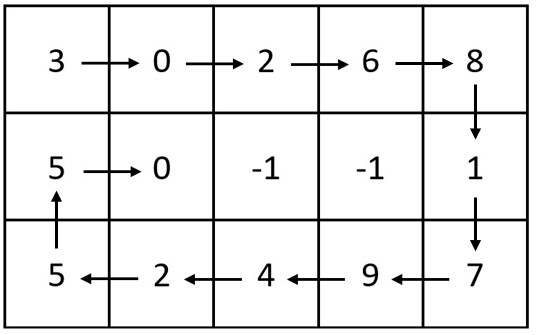You are given two integers m and n, which represent the dimensions of a matrix.
You are also given the head of a linked list of integers.
Generate an m x n matrix that contains the integers in the linked list presented in spiral order (clockwise), starting from the top-left of the matrix. If there are remaining empty spaces, fill them with -1.
Return the generated matrix.
Example 1:

Input: m = 3, n = 5, head = [3,0,2,6,8,1,7,9,4,2,5,5,0]
Output: [[3,0,2,6,8],[5,0,-1,-1,1],[5,2,4,9,7]]
Explanation: The diagram above shows how the values are printed in the matrix.
Note that the remaining spaces in the matrix are filled with -1.
Example 2:

Input: m = 1, n = 4, head = [0,1,2]
Output: [[0,1,2,-1]]
Explanation: The diagram above shows how the values are printed from left to right in the matrix.
The last space in the matrix is set to -1.
Constraints:
1 <= m, n <= 1051 <= m * n <= 105- The number of nodes in the list is in the range
[1, m * n]. 0 <= Node.val <= 1000
C++ Code
class Solution {
public:
vector<vector<int>> spiralMatrix(int n, int m, ListNode* head)
{
// Create a matrix of n x m with values filled with -1.
vector<vector<int>> spiral(n, vector<int>(m, -1));
int i = 0, j = 0;
// Traverse the matrix in spiral form, and update with the values present in the head list.
// If head reacher NULL pointer break out from the loop, and return the spiral matrix.
while (head != NULL)
{
if (j < m)
{
while (head != NULL && j < m && spiral[i][j] == -1)
{
spiral[i][j] = head->val;
head = head->next;
j++;
}
if (head == NULL)
break;
i++;
j--;
}
if (i < n)
{
while (head != NULL && i < n && spiral[i][j] == -1)
{
spiral[i][j] = head->val;
head = head->next;
i++;
}
i--;
j--;
}
if (j >= 0)
{
while (head != NULL && j >= 0 && spiral[i][j] == -1)
{
spiral[i][j] = head->val;
head = head->next;
j--;
}
j++;
i--;
}
if (i >= 0)
{
while (head != NULL && i >= 0 && spiral[i][j] == -1)
{
spiral[i][j] = head->val;
head = head->next;
i--;
}
i++;
j++;
}
n--;
m++;
}
// Rest values are itself -1.
return spiral;
}
};




